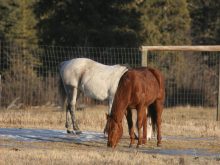The younger, the better when it comes to cattle castration, and proficient techniques will reduce stress and losses in the herd.
Band application at birth or at a young age, or knife castration at or before turnout, are the two most desirable ways. The beef code of practice requires pain control for any animal older than six months but producers already know calves do better with pain control at any age when it comes to castration. Smaller calves require little pain medication so the cost is minimal.
Read Also

Beef cattle more prone to trace mineral deficiencies
The trace mineral status of our cows and calves is a significant challenge for western Canadian producers and veterinarians.
Painkillers are rarely given to calves banded at a few days old but that will be changing quickly, at least in the U.S. and Australia, where they will soon be using lidocaine-impregnated bands. Small ones will be used in sheep for both castration and tail docking.
According to research, the bands release local anesthetic over a period of time so pain is decreased. This lidocaine impregnation will be done to the little green doughnuts we are familiar with, along with both sizes of the callicrate bands.
That should cover everything from young calves to yearlings. Licensing is proceeding well in both the U.S. and Australia/New Zealand, so soon producers will have access through their veterinarians.
In Canada we may be able to help our clients get them through the EDR (emergency drug regulations) since they may not be available here even though they are manufactured in Alberta.
The lidocaine-impregnated bands will be a stand-alone product and lots of research has been done on pain control, both short term and long term. It is a win-win for cattle producers, animal welfare and production.
I don’t know why licensing has been delayed in Canada because it involves taking preexisting bands, putting in lidocaine and then repackaging. The bands fall off with the scrotum. Necessary withdrawals are then exercised but these will be short.
Current withdrawals for lidocaine are five days before slaughter and nothing should be banded just before going to slaughter anyway.
Lidocaine local anesthetic has been used in veterinary medicine and on farms for decades.
Banding with the medium and larger callicrate bands requires a pre-existing tetanus shot and I recommend a booster when banding in order to avoid certain death if a calf gets tetanus.
If the lidocaine impregnated bands become available, it will be an automatic benefit for effective pain control and better calf performance.
One fear for producers and veterinarians when castrating by scalpel or knife is the possibility of death through a bleed out. In experienced hands, such events are rare but they can happen.
I think recovery is quicker from knife castration than from banding but we need to minimize the risk of bleeding out. Some veterinarians clamp and tie the cords with absorbable suture, some pull the cords, and others use an emasculator.
Still others tie the cord and blood vessels together and some producers use the stone castration tool. It clamps and twists the cords until they break off. I have experimented with it and find that hair sometimes gets twisted into the cord, resulting in infection. But if done properly, the risk of bleeding is low.
Nothing is perfect but whatever castration method you use, comply with the code of practice requirements.
The beef code is about to be reworked and I almost guarantee the minimum age that requires painkillers will be lowered below six months. That is just my opinion, but makes sense, especially in light of good painkillers on the market.
Each calf is worth lots of money so treat castrations as a major surgical procedure. If purebred breeders cull a bull because of a semen test, perhaps niche marketing of intact bulls is possible.
For other farm animal species, read the castration sections in their respective codes of practice.
Let’s work together to do castration as humanely as possible and then implant to recapture weight that is lost from the procedure. Implants provide hormones for growth that are lost with the testicles.
Roy Lewis works as a veterinarian in Alberta.















